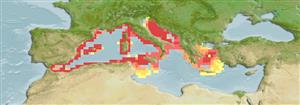Hexacorallia |
Zoantharia |
Parazoanthidae
Environment: milieu / climate zone / djupintervall / distribution range
Ekologi
. Subtropical
Distribution
Länder | FAO områden | Ekosystem | Förekomster | Utplanteringar
Atlantic and the Mediterranean: Parazoanthus axinellae adriaticus, Parazoanthus axinellae liguricus, Parazoanthus axinellae muelleri, and Parazoanthus axinellae brevitentacularis are all endemic to the Mediterranean.
Length at first maturity / Size / Weight / Age
Könsmognad: Lm ? range ? - ? cm Max length : 4.0 cm TL hane/ej könsbestämd; (Ref. 358)
Opened out, the animal, always associated in colonies, measurement up to 4 cm. Individuals: 34 tentacles laid out in double crown. Color: Yellow sharp with orange (Ref. 358).
On abrupt walls; inside underwater excavations and on sponges of the Axinella sp. kind (from where its name) and on various tunicates. Small funds until the greatest depths (Ref. 358). Known from infra- and circalittoral as well as bathyal zones (Ref. 85338).
Life cycle and mating behavior
Könsmognad | Reproduktion | Lek | Eggs | Fecundity | Larvae
Members of the class Anthozoa are either gonochoric or hermaphroditic. Mature gametes are shed into the coelenteron and spawned through the mouth. Life cycle: The zygote develops into a planktonic planula larva. Metamorphosis begins with early morphogenesis of tentacles, septa and pharynx before larval settlement on the aboral end.
Göthel, H. 1992 Guide de la faune sous-marine: La Méditerranée. Invertébrés marins et poissons. Eygen Ulmer GmbH & Co. 318 p. (Ref. 358)
IUCN Red List Status
(Ref. 130435: Version 2025-1)
CITES status (Ref. 108899)
Not Evaluated
Not Evaluated
Threat to humans
Human uses
| FishSource |
Verktyg
Ytterligare information
Trophic EcologyFood items (preys)
Födosammansättning
Födointag
Predatorer
Population dynamicsTillväxt
Max. ages / sizes
Length-weight rel.
Length-length rel.
Length-frequencies
Mass conversion
Abundans
PhysiologySyreförbrukning
Human RelatedStamps, coins, misc.
Internet-källor
Estimates based on models
Preferred temperature
(Ref.
115969): 13.3 - 17, mean 14.4 (based on 72 cells).
Fishing Vulnerability
Low vulnerability (10 of 100).
Price category
Unknown.
